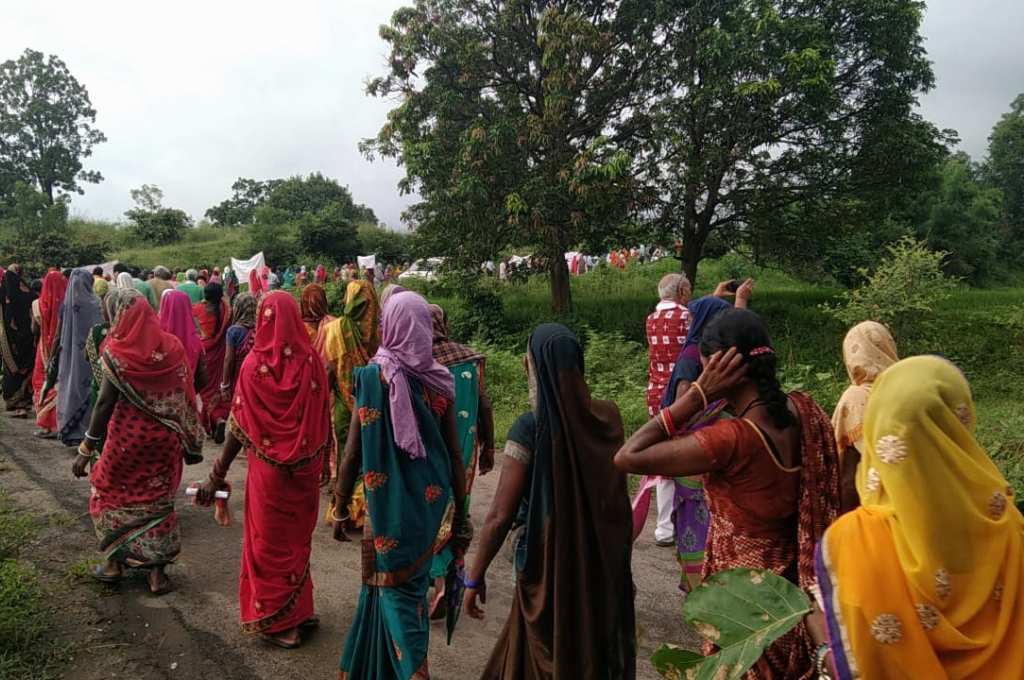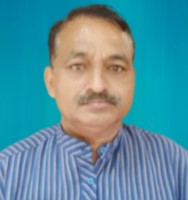जिंदाल स्टील अँड पॉवर लिमिटेडच्या गारे गावातील IV/6 खाण प्रकल्पाचे स्थानिक समुदाय आणि पर्यावरणावर काय परिणाम होतील यावर चर्चा करण्यासाठी, सार्वजनिक सुनावणीदरम्यान, छत्तीसगडच्या रायगड जिल्ह्यातील खमारिया आणि जवळपासच्या गावातील लोक, 5 जानेवारी 2008 रोजी एकत्र आले. ही एक घाईघाईने आयोजित केलेली सुनावणी होती. पंचायतींना वेळेतील बदलाची माहिती न देता घेण्यात आली होती. ही गावे तमनार ब्लॉकमध्ये आहेत, ह्या ब्लॉकचे क्षेत्र पाचव्या अनुसूचीमध्ये अंतर्भूत आहे. (मुख्यत्वे आदिवासी लोकसंख्या असलेले हे गाव आहे). हे क्षेत्र पेसा, कायदा, 1996 द्वारे संरक्षित आहे. पेसा कायद्यानुसार, अशा सुनावणीपूर्वी पंचायतींना सूचित करणे बंधनकारक असते.
यातील बरेच गावकरी मी काम करत असलेल्या जन चेतना संस्थेचा भाग होते. आम्ही खाण कंपनीला दिलेल्या पर्यावरणीय मंजुरीचा निषेध केला आणि पोलिसांनी आमच्यावर लाठी हल्ला केला; आमच्या लोकांनी प्रत्युत्तर केले तर त्यानंतर झालेल्या हिंसाचारात किमान 50 गावकरी जखमी झाले आणि अनेकांना अटक करण्यात आली. शेजारच्या गावातील रहिवाशांना हे कळले आणि अधिकाऱ्यांकडून होणारा छळ जसजसा वाढत गेला तसतसे लोक निषेध केला पाहिजे अशी धारणा बाळगू लागले.
2008 मध्ये गावकऱ्यांवर झालेल्या भयानक हिंसाचारानंतर, आम्ही आमचा निषेध अहिंसक पद्धतीने करण्याचे ठरवले होते; आम्हाला कळून चुकले की जर आम्ही संतप्त होऊन प्रत्युत्तर दिले तर अधिकाऱ्यांना आमच्या लोकांवर खोटे आरोप करण्याची आणि आमचा प्रतिकार दडपण्याची संधी मिळेल. एका बैठकीत आम्ही एमके गांधींच्या मीठ सत्याग्रहाबद्दल, त्यांच्या असहकार भूमिकेबद्दल आणि त्यांच्या दीर्घकालीन परिणामांबद्दल चर्चा केली. देशाच्या समुद्रकिनाऱ्यांवरील मीठाचा वापर लोकांच्या नैसर्गिक संसाधनांवरील सार्वभौमत्वाचे प्रतीक म्हणून गांधी करत होते. आम्ही कोळसा सत्याग्रह सुरू केला. 2 ऑक्टोबर 2011 रोजी, गांधींच्या जयंतीदिनी, आम्ही ठरवले की जर आम्हाला कोळसा अर्थव्यवस्थेत टिकायचे असेल, तर आम्ही स्वतःचा कोळसा काढावा, तो बाजारात विकावा आणि नफा समुदायाच्या कल्याणासाठी वापरला जाईल याची खात्री करावी.
आम्ही गारे गावापासून केलो नदीपर्यंत कूच केली, या नदीचे पात्र कोळशासाठी सुपीक आहे. आम्ही तिथली जमीन खोदली आणि ३ टन कोळसा गावात परत आणला. पुढचे पाऊल म्हणजे खरेदीदार शोधणे. आमच्यामध्ये वीटभट्टी आणि ढाब्यावर काम करणारे लोक होते, म्हणून आम्ही या नेटवर्कचा वापर करण्याचा निर्णय घेतला. आम्ही लिलावात भट्टी आणि ढाबा मालकांना सहभागी करून घेतले आणि त्यांना कोळसा विकला.
मात्र, स्वतःचा कोळसा व्यवसाय सुरू करणे हा कोळसा सत्याग्रहाचा फक्त एक पैलू आहे. आम्ही एकमेकांकडून शिकतो आणि शिक्षण, आरोग्यसेवा आणि जमीन हक्कांसह लोकांच्या विविध गरजांवर काम करतो. आम्ही कॉर्पोरेट खाणकामांविरुद्ध निदर्शने देखील आयोजित करतो आणि आमच्या क्षेत्राबाहेरील लोकांना या समस्यांची जाणीव व्हावी यासाठी एक मीडिया इकोसिस्टम देखील आम्ही तयार केली आहे.
2023 मध्ये, सत्याग्रहाला 12 वर्षे पूर्ण झाली. नवीन वर्षात पाऊल ठेवत असताना, ग्रामीण भारतातील कॉर्पोरेट खाणकामाच्या विरोधात चळवळ टिकवून ठेवण्याच्या आमच्या अनुभवाबद्दल आम्ही जे धडे शिकलो त्याबद्दल येथे सांगू इच्छितो. आमचा संघर्ष छत्तीसगडमधील कोळसा खाण कंपन्यांविरुद्ध आहे, परंतु आम्हाला विश्वास आहे की देशातील कोणत्याही समुदायांसाठी, जे त्यांच्या जमिनी आणि नैसर्गिक संसाधनांवरील कॉर्पोरेट अधिग्रहणाला विरोध करत आहेत, आमच्या या पद्धतीचा फायदा होऊ शकतो. चळवळीचा एक भाग म्हणून, आम्ही पुढील प्रमाणे कामे केली:
लोकांना शिक्षित करणे
1. लोकांकडून शिका आणि त्यांच्या गरजांशी जुळवून घ्या
चळवळीच्या सुरुवातीच्या काळात, आम्ही लोकांचा अन्न आणि पेन्शनचा अधिकार यावर लक्ष केंद्रित केले. पण बैठकांमध्ये आमच्या सदस्यांनी आम्हाला विचारले, “जर आमच्याकडे जमीन नसेल तर आम्ही अन्न आणि पेन्शनचे काय़ करणार?” मग आम्ही जमिनीच्या हक्कांवर काम करण्यास सुरुवात केली. आमचे बरेच सदस्य भूमिहीन आदिवासी होते, म्हणून आम्ही त्यांच्या जमिनीच्या कागदपत्रांसह त्यांचे सामुदायिक वन हक्क मिळविण्यात मदत करण्यास सुरुवात केली.
खाणकामामुळे जमीन गमावणाऱ्या शेतकऱ्यांना कोल इंडियाने प्रति एकर 5 लाख रुपये आणि भरपाई म्हणून एक छोटासा भूखंड देणे अपेक्षित आहे. आमच्या समुदायातील नेत्यांच्या मदतीने, आम्ही लोकांच्या तक्रारी अधिकाऱ्यांकडे आणि गरज पडल्यास न्यायालयात नेण्यास सुरुवात केली.
मात्र, आम्हाला हे लक्षात आले की भरपाई हा सर्वोत्तम उपाय असू शकत नाही, कारण तो लोकांना मर्यादित काळासाठीच पुरतो. आमच्या गावांमध्ये, विधवा आणि तरुण होते आणि त्यांनी त्यांच्या कुटुंबातील कमावत्या सदस्यांना गमावले होते. आर्थिक भरपाईऐवजी, कोल इंडियाकडे खाणकामासाठी ज्यांची जमीन घेतली आहे त्यांना रोजगार देण्याचा पर्याय देखील आहे. आमच्या भागातील अनेक आदिवासी कुटुंबांना औपचारिक रोजगार स्वीकारण्यास तयार करण्यासाठी जन चेतना सदस्यांना थोडा वेळ लागला. आम्ही त्यांना समजावून सांगितले की 5 लाख रुपये कधीतरी संपतील, परंतु सार्वजनिक क्षेत्रातील नोकरी त्यांना नियमित उत्पन्न मिळवून देऊ शकते. आम्ही त्यांना नोकरीचे अर्ज भरण्यास मदत करतो. आवश्यकतेनुसार, आम्ही त्यांना खाजगी कंत्राटदारांद्वारे रोजगार मिळविण्यात देखील मदत करतो. यातील अनेक कुटुंबे भूमिहीन असल्याने, आम्ही कोल इंडियाशी बोललो आणि लोकांसाठी लघू उद्योग तयार करण्यास मदत केली.
आम्ही तरुणांना शिक्षित करण्यावर खूप लक्ष केंद्रित करतो. त्यापैकी बरेच जण आमच्या संघटनेत सामील होतात किंवा इतर क्षेत्रांमध्ये त्यांच्या समुदायांच्या समस्यांवर काम करतात. आमच्या सर्व मेळाव्यांमध्ये आम्ही हे सांगण्याचा प्रयत्न करतो की तरुणांनी शिक्षणाचा वापर वैयक्तिक विकासा बरोबरच त्यांच्या समुदायासाठीकेला पाहिजे.

2. माहितीचा योग्य प्रसार करा
संघटनेचा भाग असलेले तरुण तंत्रज्ञानात कुशल आहेत. आम्हाला येथे स्वतःची मीडिया इकोसिस्टम तयार करण्याची संधी मिळाली.
चळवळीच्या सुरुवातीला, काही वेळा असे व्हायचे की जेव्हा आम्ही मुख्य प्रवाहातील माध्यमांना एखादा मुद्दा सांगायचो तेव्हां ते पूर्णपणे वेगळे चित्र दाखवायचे; उदाहरणार्थ, ‘खाणकामाच्या विरोधात 200 लोक आले’ हे ‘खाणकामाच्या समर्थनार्थ 200 लोक आले’ असे नोंदवले जायचे. आम्ही व्हिडिओ व्हॉलंटियर्स सारख्या पत्रकारितेत तज्ज्ञ असलेल्या ना-नफा संस्थांच्या मदतीने आमच्या स्वतःच्या लोकांना प्रशिक्षण देण्यास आम्ही सुरुवात केली.
सुरुवातीला आम्ही चार लोकांना – दोन मुले आणि दोन मुली – 15 दिवसांचे प्रशिक्षण घेण्यासाठी पाठवले. या ना-नफा संस्थेने त्यांना कथा ओळखण्यास, व्हिडिओ शूट करण्यास आणि प्रभावीपणे संदेश पोहोचवण्यास मदत केली. दोन ते तीन महिने, त्यांनी खाण क्षेत्रात रस्ते, पायाभूत सुविधा आणि आरोग्यसेवा यासारख्या समस्यांवरवर लक्ष केंद्रित करून काम केले. त्यांनी या विषयांवर दोन-तीन मिनिटांचे माहितीपट बनवले.
व्हिडिओ व्हॉलंटियर्स त्यांना प्रत्येक माहितीपटासाठी 1,000 रुपये देतात. जेव्हा ते त्याच विषयावर पुढील माहितीपट बनवतात तेव्हा त्यांना 2,000 रुपये मिळतात म्हणजे त्यांचे उत्पन्न स्थिर होते. आमच्या 10 सदस्यांपैकी प्रत्येकजण आता सरासरी 10,000-15,000 रुपये दरमहा कमावतात आणि आम्ही चांगले ग्राउंड रिपोर्टिंग देखील करतो. आम्ही हे व्हिडिओ नियमितपणे इंस्टाग्राम, फेसबुक, व्हॉट्सअॅप आणि एक्स (पूर्वीचे ट्विटर) सारख्या सर्व सोशल मीडिया चॅनेलवर पोस्ट करतो जेणेकरून लोकांना त्यांच्या समुदायांमध्ये असे काम करण्याची प्रेरणा मिळेल. आम्ही हे व्हिडिओ स्थानिक प्रिंट आणि डिजिटल मीडिया आउटलेटमध्ये देखील प्रसारित करतो. जेव्हा ते या कथा प्रकाशित करतात तेव्हा ते आम्हाला फोटो आणि वर्तमानपत्रातील कटिंग्ज पाठवतात; याने आमच्या सदस्यांना पुढे जाण्यास प्रोत्साहन मिळते.
लोकांना संघटीत करा
1. ग्रामसभेत प्रतिनिधित्व वाढवा
पेसा कायदा ग्रामसभेला अनुसूचित क्षेत्रातील गावांचा कारभार करण्याचा अधिकार देतो. तो आदिवासी समुदायांचे नैसर्गिक संसाधनांवरील अधिकार मान्य करतो आणि ग्रामसभा विकास प्रकल्पांना मान्यता द्यायची का नाकारायचे हे समुदाय ठरवू शकतात. ग्रामसभा समुदायांना त्यांचे मत मांडण्यासाठी आणि बदल घडवून आणण्यासाठी एक व्यासपीठ आहे.
हे ओळखून, आम्ही गावातील महिला नेत्यांना पंचायत निवडणुकीत सहभागी होण्यासाठी प्रशिक्षण देण्यास सुरुवात केली. सध्या, आम्ही ज्या 15-16 महिला आणि आदिवासी सदस्यांसोबत काम करतो त्या जनपद पंचायती (ब्लॉक-स्तरीय पंचायत) चा भाग आहेत, जे ग्रामपंचायत आणि जिल्हा (जिल्हास्तर) पंचायतीमधील दुवा आहेत. या खाण क्षेत्रात राहणाऱ्या लोकांच्या कल्याणासाठी जिल्हा खनिज प्रतिष्ठान आणि सीएसआर पैशाचा योग्य वापर करण्याची मागणी करण्यास हे पंचायत सदस्य आम्हाला मदत करत आहेत. त्यांनी या भागात कार्यक्षम पीडीएस वितरण सुनिश्चित करण्यास देखील आम्हाला मदत केली आहे.
2. कंपनी स्थापन करा
2011 मध्ये, आम्ही अधिकाऱ्यांना दाखवून दिले की आम्ही आमच्या जमिनीचे उत्खनन स्वतः करू शकतो आणि त्यातून मिळणारा नफा गावांमध्ये वाटला जाईल याची खात्री करू शकतो. मात्र, आम्हाला सांगण्यात आले की आमचे खाणकाम बेकायदेशीर आहे आणि फक्त कंपन्याच कोळसा काढू शकतात. आम्ही अधिकाऱ्यांना सांगितले की आमच्याकडे कंपनी नाही पण आम्ही काही महिन्यांत ती स्थापन करू शकतो. मग अधिकाऱ्यांनी आम्हाला विचारले, “ कंपनी सुरू करण्यासाठी आवश्यक असलेल्या पात्रता तुम्हाला माहिती आहेत का? त्यासाठी किती पैसे लागतात हे तुम्हाला माहिती आहे का?” आम्ही त्यांना सांगितले की आमच्या गावातील प्रत्येक घरात अंबानी आणि जिंदाल यांच्याइतकाच शिक्षित व्यक्ती आहे. आम्ही त्यांना सांगीतले की कोणीही खाण कंपनी सुरू करण्यासाठी वैयक्तिक निधी वापरत नाही. जेव्हा सरकार आमची जमीन जप्त करते आणि ती खाजगी कंपनीला देते, तेव्हा कंपनी सामान्यतः जमिनीचा वापर बँकेकडून कर्ज मिळवण्यासाठी तारण म्हणून करते. आमचा प्रस्ताव सरळ होता: जर तुम्ही त्यांना 40 लाख रुपये देऊ शकत असाल, तर खाणकामासाठी आम्हाला 10 लाख रुपये द्या आणि आम्ही शाश्वत खाणकाम कसे करता येते हे दाखवू.
2013 मध्ये, गारे ताप उपक्रम उत्पादक कंपनी लिमिटेडची नोंदणी शेतकरी उत्पादक कंपनी म्हणून झाली. आम्ही बाह्य निधीशिवाय हे शक्य आहे असे सिद्ध करण्यासाठी एका वर्षासाठी १ एकर जागेवर कोळसा उत्खनन केले. आम्ही अशा कंपनीत महिला, तरुण जमीनदार आणि भूमिहीन शेतकऱ्यांच्या भूमिका कशी असेल यावर चर्चा केली. आम्ही एकत्रितपणे ठरवले की आम्ही कमावलेले पैसे थेट ग्रामसभेत जमा होतील, ज्यातून गावांमध्ये आरोग्यसेवा, वीज आणि स्वच्छ पाणी यासारख्या मूलभूत गरजा पुरवण्यास मदत होऊ शकेल.
लोक त्यांच्या कंपनीला त्यांची जमीन देण्यास तयार होते. त्यांनी आम्हाला त्यांच्या जमिनीच्या कागदपत्रांच्या प्रती आणि त्यांच्या जमिनीवर खाणकाम करण्यासाठी ना-हरकत प्रमाणपत्रे देऊ केली. आता, आमच्याकडे लोकांनी दिलेली 700 एकर जमीन आहे. सरकारने आम्हाला कोणत्याही खाणी दिल्या नसल्या तरी, आम्ही आमच्या फावड्यांनी कोळसा खोदत राहतो.

आंदोलन ऊभे करा
1. न्यायालयात लढा
आमच्या कामाच्या प्रत्येक टप्प्यावर, आमच्या लोकांना त्यांच्या हक्कांसाठी कायदेशीर लढाया लढाव्या लागल्या आहेत. उदाहरणार्थ, खाण कायदा, 1952 नुसार महिलांना कोळसा खाणींमध्ये काम करण्यास मनाई होती. आमच्या समुदायातील एक सदस्य असलेल्या राठो बाई यांनी एका खाण अपघातात तिचा भाऊ आणि तिचे वडील गमावले होते. जर ती महिला नसती तर तिला कोल इंडियामध्ये नोकरी मिळाली असती. म्हणून आम्ही कोल इंडियाला छत्तीसगड उच्च न्यायालयात विरोध केला आणि युक्तिवाद केला की जेव्हा संविधान लिंगाच्या आधारावर भेदभाव करत नाही, तर खाण कायदा कसा करू शकतो? परिणामी, राठो बाईंना नोकरी मिळाली.
त्यानंतर रथकुमारचा खटला होता, तिच्या पतीचा कोल इंडियाच्या खाणीत काम करताना हृदयविकाराच्या झटक्याने मृत्यू झाला होता. जेव्हा कंपनीने सांगितले की तिच्या पतीने त्या खाणीत काम केलेले नाही, तेव्हा आम्ही माहिती अधिकारात अर्ज दाखल केला आणि न्यायालयात ते खोटे बोलत असल्याचे सिद्ध केले. रथकुमारलाही नोकरी मिळाली. खाणकाम करणाऱ्या महिलांच्या यशोगाथांमध्ये राथोबाई आणि रथकुमार यांचा समावेश आहे.
2. निषेध करत राहा
आमचा सत्याग्रह निषेधांपासून सुरू झाला आणि ही आंदोलने आमच्या चळवळीचा कणा बनली. गेल्या काही वर्षांत ती हळूहळू वाढत गेली आहेत. 2012 मध्ये, जेव्हा सत्याग्रहाच्या दुसऱ्या वर्षात प्रवेश केला, तेव्हा आम्ही जवळच्या गावांतील सदस्य आणि प्रतिनिधींसोबत बैठका घेण्यास सुरुवात केली. आम्ही राष्ट्रीय स्तरावर आमच्या ओळखीच्या संघटनांनाही आमंत्रित केले; त्यात 16 राज्यांतील लोक सहभागी झाले. काहींना बॉक्साईट खाणकामाचा त्रास होता, तर काहींना लोहखनिज खाणकामाचा त्रास होता, आम्ही सांगितले की आम्ही कोळसा सत्याग्रहाचा पर्याय निवडला कारण आम्ही कोळसा खाणींनी वेढलेले होतो, आणि आमचे मॉडेल अनुकरणीय होते.
आम्ही आमच्या सदस्यांसोबत इतर गावांमध्ये आणि राज्यांमध्ये होणाऱ्या आंदोलनांना आणि चळवळींना भेटी देतो जेणेकरून आम्हाला त्यांच्याकडून शिकता येईल. आमच्याकडे संसाधने कमी आहेत, पण लोक मदत करतात. आम्ही गावातील प्रत्येक घरातून एक मुठभर तांदूळ मागतो. ज्यांना जास्त देणे शक्य असते ते जास्त देतात आणि काही जण चळवळ चालू ठेवण्यासाठी पैसे देखील देतात. 2024 मध्ये, आम्ही सामुदायिक देणगीसाठी एक नियम बनवला आहे – ज्यांच्याकडे 1 एकर जमीन आहे ते 100 रुपये देतील आणि ज्यांच्याकडे 10 एकर जमीन आहे ते 1,000 रुपये देतील. आम्ही आधीच अंदाजे 8.5 लाख रुपये ऊभे केले आहेत आणि अंदाजे 40 क्विंटल तांदूळ गोळा केला आहे. जेव्हा जेव्हा मोर्चा, वाहतूक कोंडी किंवा धरणे आंदोलन असते तेव्हा हे पैसे आणि तांदूळ आम्हाला आधार देतात. आम्ही एक प्रोजेक्टर, एक संगीत प्रणाली, एक प्रिंटर, एक लॅपटॉप देखील खरेदी केला आहे. किती पैसे गोळा झाले आहेत आणि पैशासाठी कोण जबाबदार आहे हे सर्वांना माहिती आहे. यासाठी संपूर्ण आर्थिक पारदर्शकता राहील याची आम्ही खात्री करतो.
चालू असलेल्या निदर्शनांमध्ये, लोकांचे जीवनमान विस्कळीत होऊ नये म्हणून, प्रत्येक गाव एक दिवस निदर्शने आयोजित करण्याची जबाबदारी घेते. उदाहरणार्थ, जर माझ्या गावातील 500 लोक आज गेले तर उद्या दुसऱ्या गावाची पाळी असेल.
सध्या देखील कंपन्या येथे खाणी उभारण्याचे प्रयत्न करत आहेत, पण रायगडमधील आणि आजूबाजूच्या गावांमधील लोकांनी अशा सर्व प्रयत्नांना हाणून पाडण्यात यश मिळवले आहे. जोपर्यंत ते आमच्या संसाधनांसाठी येत राहतील तोपर्यंत आम्ही त्यांच्या विरोधात उभे राहू आणि स्वतःचे रक्षण करू. आम्हाला आमच्या गावांमध्ये कोळसा खाणी नको आहेत, परंतु जर सरकारला विकासाचा हा एकमेव मार्ग आहे असे वाटत असेल, तर आम्हाला त्यात आमचा वाटाही हवा आहे.
मूळ इंग्रजीतील लेखाचा मराठी अनुवाद करताना ट्रांसलेशन टूलचा वापर केलाआहे. सुशीलकुमार सडोलीकर यांनी अनुवादीत लेख तपासण्याचे व संपादनाचे काम केले आणि अंकिता भातखंडे यांनी याचे पुनरावलोकन केले आहे.
—
अधिक जाणून घ्या
- कोळशापासून न्याय्य संक्रमणासाठी भारताला त्याच्या ऐतिहासिक चुका का दूर कराव्या लागतील हे जाणून घ्या.
- छत्तीसगडमधील आदिवासी समुदायांवर व्यावसायिक खाणकामाचा कसा परिणाम होतो ते समजून घ्या.
- भारतातील आदिवासी समुदायांसाठी नियामगिरी प्रकरणाचे महत्त्व आणि परिणाम जाणून घ्या.





